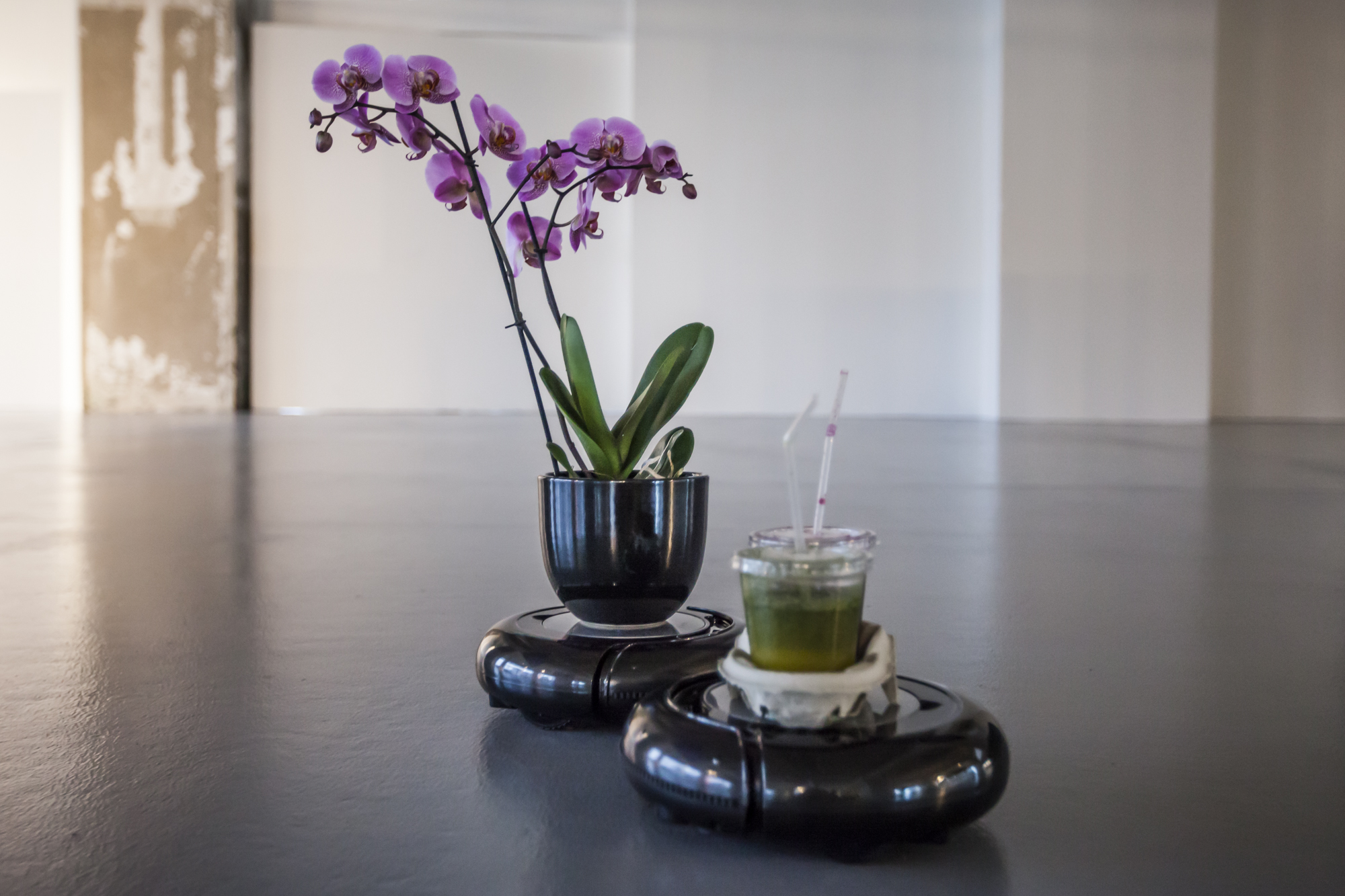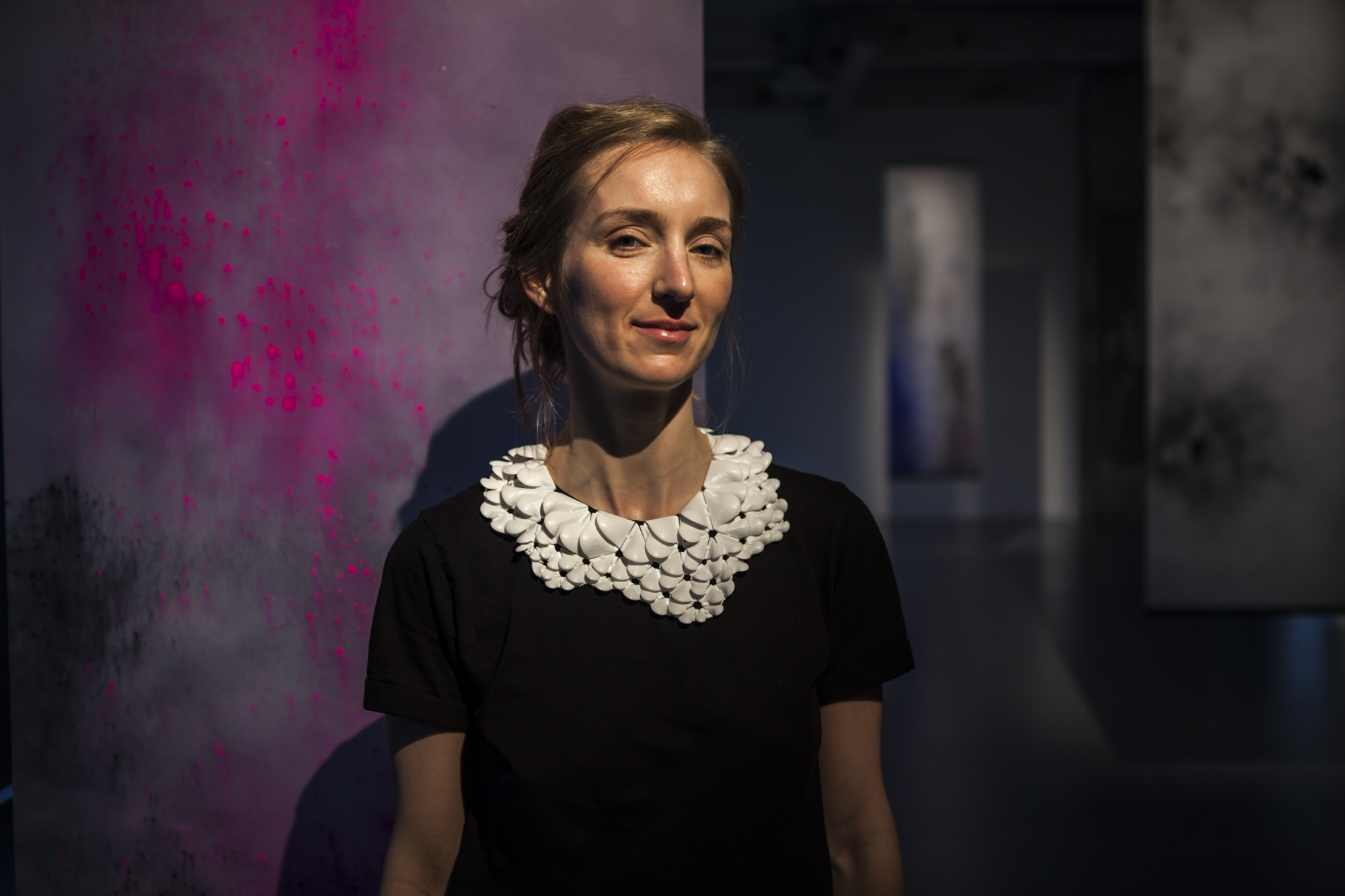
Addie Wagenknecht at MU, Eindhoven. Photo © Hanneke Wetzer.
Borders evoke conflict and definitions. Borders are often invisible or at least presented in an invisible way until a glitch reveals some or all of their mass, making way for vulnerability that allows us to slip in. According to American artist Addie Wagenknecht, this can be applied to gender, women’s roles in society, as much as it can be applied to refugees waiting at European borders, as well as to the invisible borders on and of the internet. In her solo-exhibition Liminal Laws, Wagenknecht critically examines the concept of borders and the laws that govern them. She explores the tension between technology and expression by zooming in on digital networks and developments that create a range of liminal situations.
The exhibition shows the results of this exploration in a series of works including a 1:1 scale model of a drone, a CCTV chandelier, paintings created by drones, contemporary still lives, and a video installation that loops the spinning wheel that represents the loading, booting and buffering status of a Mac computer. MU has commissioned Wagenknecht to make a new work for the occasion that reframes familiar themes in the light of current technologies. This resulted in the Liberator Gun Vases (2016), based on the first 3D printable gun made widely available online. The Liberator gun is not meant to kill but to demonstrate the elusiveness of control on the internet. It has become a contemporary symbol for freedom of expression, open source technology and resistance against authorities. The Liberator Gun Vases are also 3D printed and their form refers to classic Greek vases, in that way taking us back to the dawn of democracy and the systematic pursuit of knowledge.
I talked to Wagenknecht, who swapped New York for the Alps, about appropriation, the use of social media, the influence of the internet on relationships, drones, and whether or not there is gender to art.
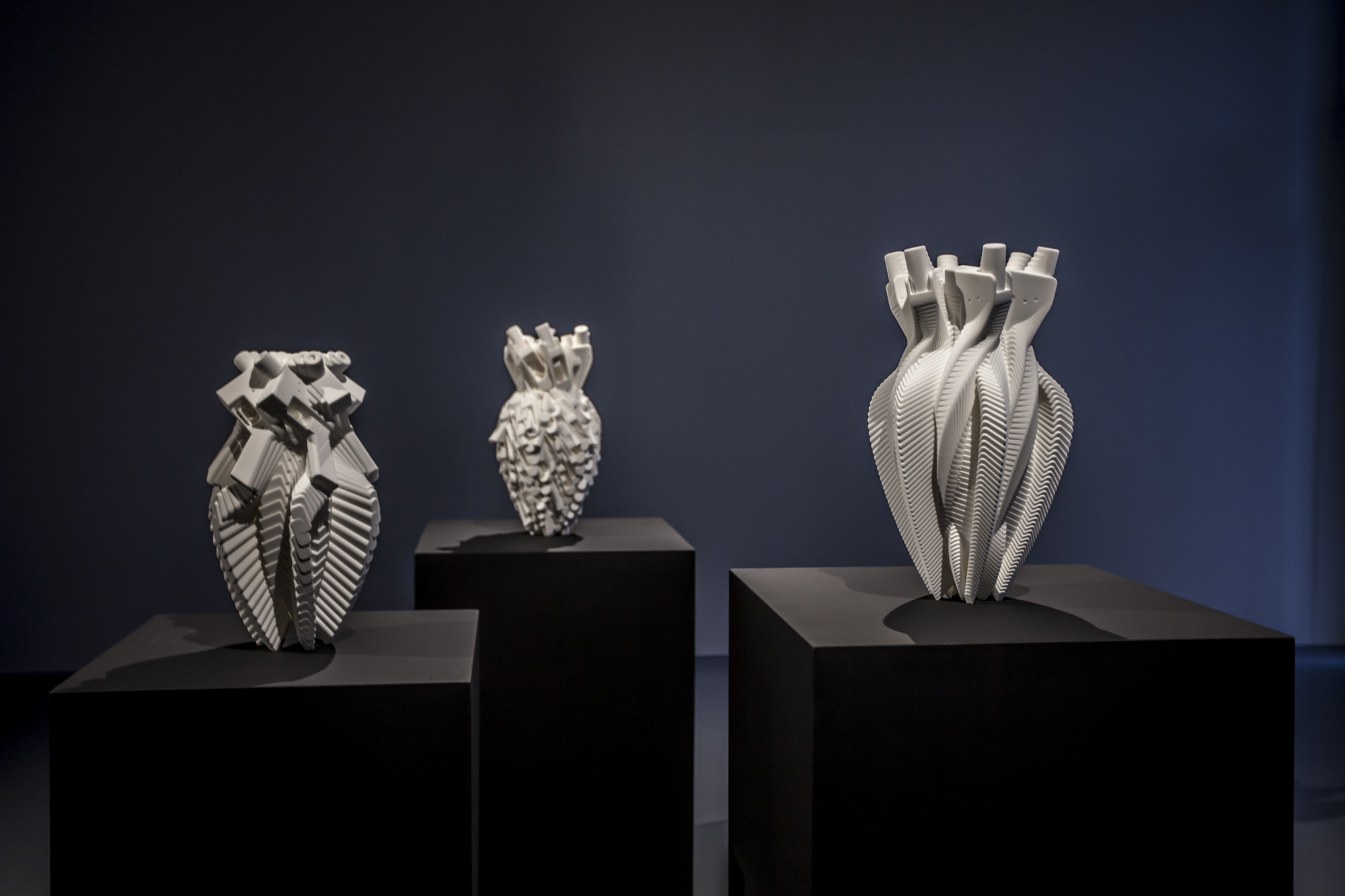 Liberator Gun Vases (2016) by Addie Wagenknecht, Martin Zangerl and Stefan Hechenberger, commissioned by MU. Photo © Hanneke Wetzer.
Liberator Gun Vases (2016) by Addie Wagenknecht, Martin Zangerl and Stefan Hechenberger, commissioned by MU. Photo © Hanneke Wetzer.
NR: Can you tell me something about your background? What led you to the work you are making now?
AW: To start with my education, I did my undergraduate in… I guess they called it at the time computer science and digital art. I was doing primarily game development for non-profit and non-governmental organizations in the United States. When I went to grad school I went to ITP (Interactive Telecommunications Program) at New York University. They bring together mathematicians, engineers, theatre people and photographers, a strange mix of people. It was like a think thank; they throw you in a room together. It is very open, there are not a lot of restrictions, and you have access to all kinds of materials and equipment. That was where I started playing with physical computing; androinos, microcontrollers and other stuff to create basic robotics.
While I was there I applied for fellowships because I didn’t really know what I wanted to do yet. I always thought the track was like: you go to graduate school, you do art things, and then you get a job at a corporation and you never do art again. I always assumed I was going to go to work in advertising or marketing. One of the fellowships was at Eyebeam, a big art and technological centre in New York City I had never heard of. One of the people on the committee had seen a piece that I had had in the student show and kind of nudged my application in. Not realizing it was a big deal, I went for the interview and got the fellowship. When I saw the list of people at Eyebeam and recognized their names it was scary and humbling. I was still in school and these people had years and years of practical experience. I was thrown into an amazing group of people who became my friends. It was a great experience.
Thing after thing kept happening. At some point I looked back and realised I had been out of school for 10 years and I’m still writing applications every few months. The turning point was in 2013. I was in an auction for digital arts called Paddles On! organised by Phillips and online auction house Paddle8. They were selling a piece I had done for an exhibition no-one had shown a lot of interest it in. When my piece (Asymmetric Love, Number 2, 2013) was the top selling lot for the auction, I felt that I might actually be able to do this. Suddenly I had galleries calling me, and people wanting to show and support my work.
One of the things of being in this network society is that we are so often isolated from each other. Sometimes you feel like you are crazy because you are always by yourself working on stuff and you don’t have someone to say that it is a good idea. It is you outputting, outputting, outputting, throwing it on the internet and see what happens.
NR: Throwing your work online and seeing what happens, is that how you test your ideas?
AW: Around the time I was at Eyebeam I joined F.A.T. Lab (The Free Art & Technology Lab). All of us were always throwing out ideas, making things quickly, reacting to what was in the news, in culture and pop culture. This became a way for me to get things out and not overthink it. When you work too long on something you tend to get to a point where you are scared to release it because you feel like it is not done or because you start seeing the errors. If you are fast and put it out you do not have time to think about how you could do it better. It has become a way of how I practice.
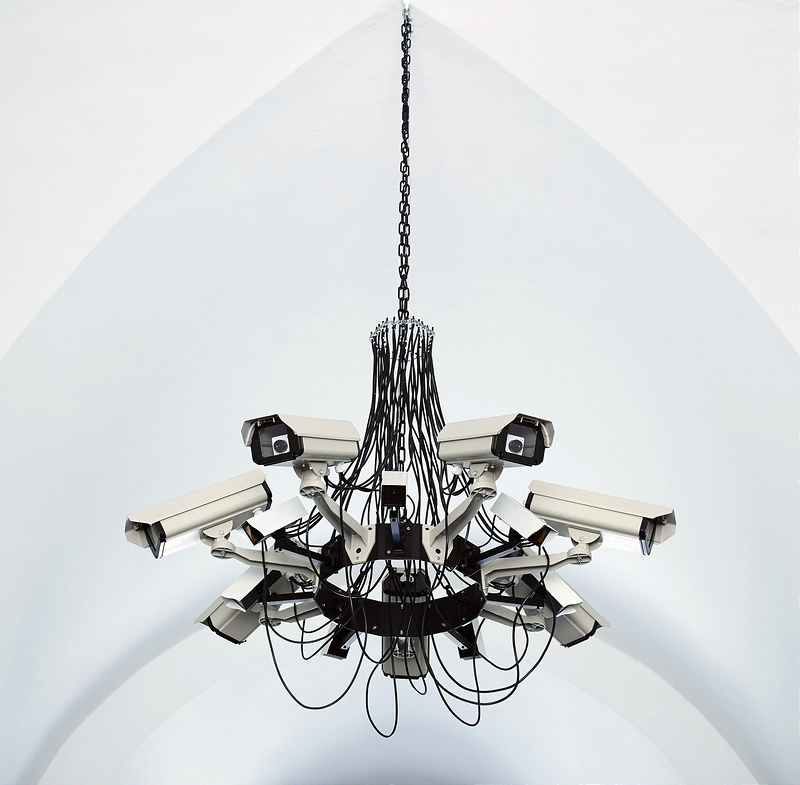
Asymmetric Love (2013) by Addie Wagenknecht.
NR: In spite of your open-source background you are very active on social media platforms such as Facebook, how do you manage this contradiction?
AW: Open source does not mean closed to social media corporations. It means a different way of expressing your output personally. I use Facebook 99% for stuff that I want to project or announce to the world – except for some pictures of my dog. I do not use it as a private platform in any way. I do not have any sort of filters; everything I post on my Facebook is public, you do not need an account to see what I post. I am using it as another outlet to advertise my own work. If you use social media right you sort of become your own corporation. It is like you proliferate your ideas. Some of my tweets have been taken and they have been put on news sites and into articles with 5000 favourites it or retweets, more people read that than would ever talk to me personally.
NR: The exhibition’s press release states that you critically examine the concept of borders and the laws that govern them. You explore the tension between technology and expression by zooming in on digital networks and developments that create a range of new liminal situations. Can you explain what you mean with ‘liminal situation’?
AW: It is this situation where it is not black or white; the grey spaces. Exploring things that can be either/or. In a way, the quote by Melvin Kranzberg: “Technology is neither good nor bad; nor is it neutral” is the thesis of the show. It is plainly the idea that technology can be all those things. How we use it or do not use it. How we ignore it or choose to accept it. Think of the way we participate in social media: we are the product, yet we do not like it. We are still hanging onto Facebook but we also hate it. There is a weird dichotomy between Facebook being evil, and us depending on it for friendships. If we delete Facebook, we delete our friends. The liminal questions if it can be all those things at once? And how do you parse that in your own mind? If everything can be good but is also bad, it is a horrible situation. How do you manage that? We are at this time where everything is coming together at once. And it is very complex; nothing like this has happened before. Never before have we been so globally embedded and together but yet totally alone and isolated. It is a very weird dichotomy of being smothered but also completely alone.
Playing with what I call the ‘crisis of intimacy’, in some of the works in the exhibition I tried to remove myself somehow, either through collaboration, by using computers, or in a way of not even touching the work. Some works I only saw on the screen before they were fabricated, and people that were installing it touched the fabrication. I touched the code that became a work, but I never touched the works. This weird removal of the self from the process can be applied to many aspects of our lives. You do not touch the physical thing. You use your phone to find a date and you interact through the screen to do something that normally you would have gone outside to do.

Still Alive, number 2 (2016) by Addie Wagenknecht and Aiala Hernando.
NR: Your work is often a mixture of digital objects and analogue media, ‘natural’ objects and references to artistic traditions. What is it about these traditional forms that attract you?
AW: I like playing with the idea of things that are familiar. You recognize the form but the actual details within the work are something contemporary. With the series Still Alive (2015) I like this idea of taking something that is expected and ubiquitous in the canon of traditional art and re-appropriate it so that it speaks to the contemporary audience as well as retaining what it originally attended to. This remix culture is what the internet is so good at. When you release things on the net you loose ownership in a way, which is very cool and exciting. You see how people appropriate. Liberator Gun Vases (2016) is about this appropriation, taking the gun and seeing how to appropriate it. Does the gun at some point dissolve into another form or does it remain the gun?
NR: Internet of Things (2016) consists of three robotic vacuum cleaners that roam around the exhibition space carrying an orchid, a pizza and a box of soylent. It is about us trying to save time to be more productive, and therefore adjusting our environment to robotics. Can you explain this work a bit more?
AW: Each roomba (robotic vacuum cleaner) has a different function. There is one roomba that has an actual wifi network. The other one has a signal jammer that breaks the internet. The third has a Tor exit node, which is a way to anonymize your network traffic. Depending on the proximity of the roombas within the space, which is determined by their algorithm, the internet will either function, be encrypted, or cease to function. The items placed on the roombas are used to conceal the wifi hotspot, signal jammer and tor exit node hardware but also play off and comment on cubicles within corporate spaces. It is the play of the internet of things; we are trying to make everything super-hyper-automatic and autonomous but yet it is constantly failing on us. I wanted to play with that frustration. At the same time there is the joy of it being automatic but finding out that the automatic is actually more work than if it was something you were doing yourself. For example, with the vacuums it seems such a good idea but then when you start running it, you are like shit… I still have to vacuum.
Internet of Things, Number 1-2 (2016) by Addie Wagenknecht. Photo © Hanneke Wetzer.
NR: There seems to be a notion of uselessness in Internet of Things (2016). Has your work got anything to do with suffering from a lack of meaning, or a comfort in uselessness in today’s society?
AW: Maybe unintentionally. I think it is commonly known as this notion of hyper-consumerism, not so much in Europe but very much in American culture. There is such a contrast between European and American cities in the amount of waste, products, and people just buying without even realizing that they are spending the money. In the United States it is like people are robots, they do not even realize they are just buying for the sake the habit. My friends in the United States have hundreds of thousand of dollars in debt and they do not even know what they have spent it on. A powerful statement of how society is broken because of uselessness. We have tried so hard to hyper-automize everything that we become numb to our basic needs. We keep trying to fill up people with all this crap, while they just need to be able to go outside and stop looking at the computer.
NR: You have been working with drones for more than 10 years. How do you think the drone as both a tool and subject matter has changed over the years, and how has this influenced your drone works?
AW: When I started using drones nobody really knew what they were. Only more recently, with the Snowden revelations and the ubiquitous of the internet, they see them and images they make and start to realize what they are. While You Were Sleeping (2016) is about the realization of how immense they are. The piece is a 1:1 scale. They fly over places where people are being killed for no reason or because of their metadata, because their cell phone was within the same range of someone on the suspect list. It is irresponsible and crazy and still being really well hidden from society. Hopefully raising the question and making people realize what is going on might bring some awareness to it, at the very least.
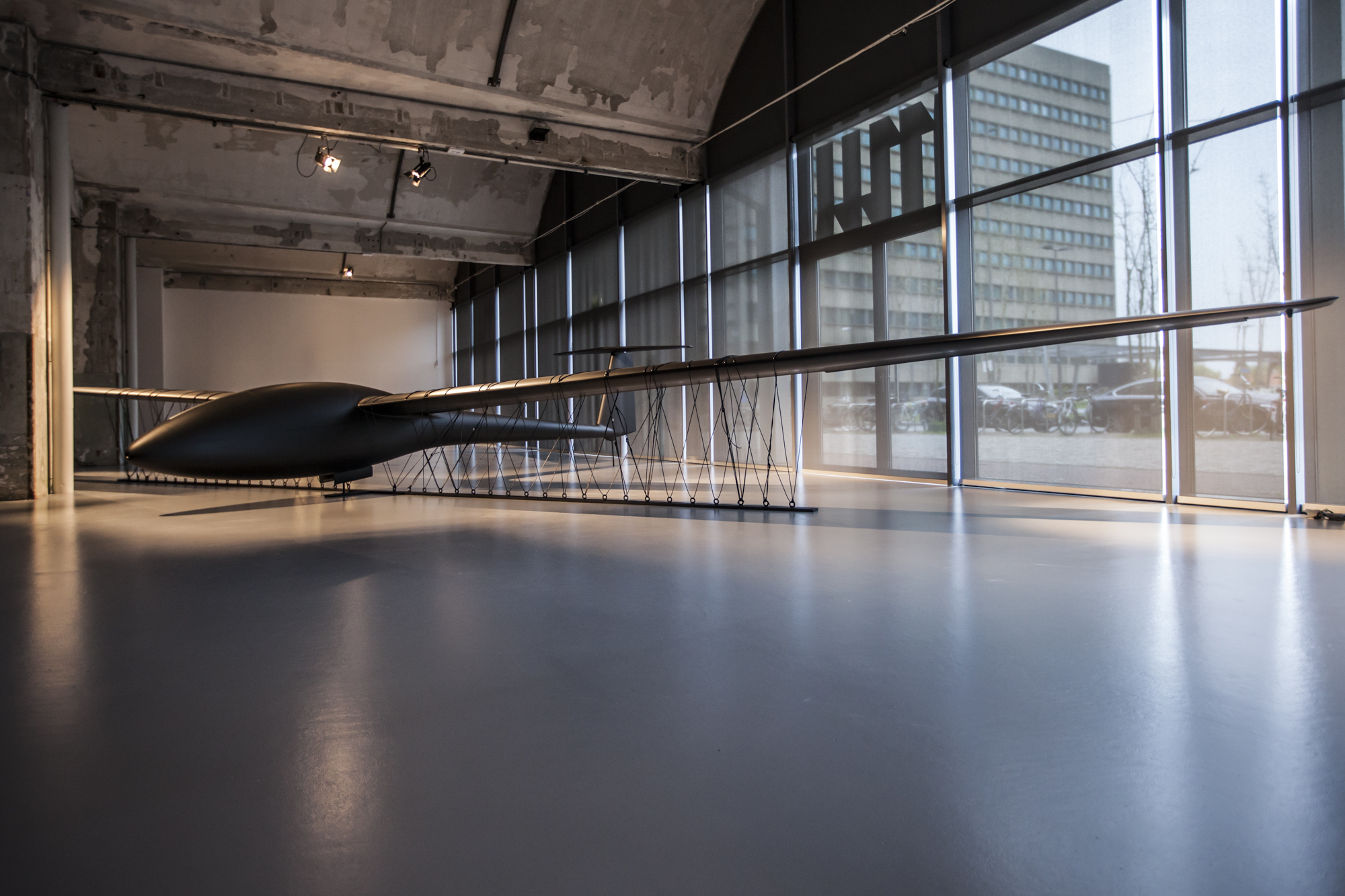
While You were Sleeping (2016) by Addie Wagenknecht. Photo © Hanneke Wetzer.
NR: The drone paintings – works of art made by programmed drones – as well as the Internet of Things (2016) raise questions about computers and machines taking over not only repetitive, boring, physical tasks, but more creative ones as well. Do you think they will eventually take over the art world?
AW: That is what I am hoping in a way. My original intention with the drone paintings 10 years ago was to appropriate the drones used to kill people as a tool for something creative or beautiful. Artists have always taken whatever is ubiquitous of that time and used that as a material. I wanted to play with that idea. Maybe it was part of my open source background that I wanted to visualize that possible appropriation and usage so that other people start doing it.
I don’t know if I had any influence or not, but other people using drones for art is really awesome and exciting because you start seeing the potential to reassign and re-appropriate this into something that is not just used to kill people but to do something more docile and beautiful.
NR: How far do you think your art can go?
AW: I think art as a movement can redefine politics and systems quite well. I am not sure yet if a single person can. I think that is true with everything, any field takes a movement of people to do it and not just a single person. I do not believe that my work alone can do it but I believe that there are enough of us doing it.
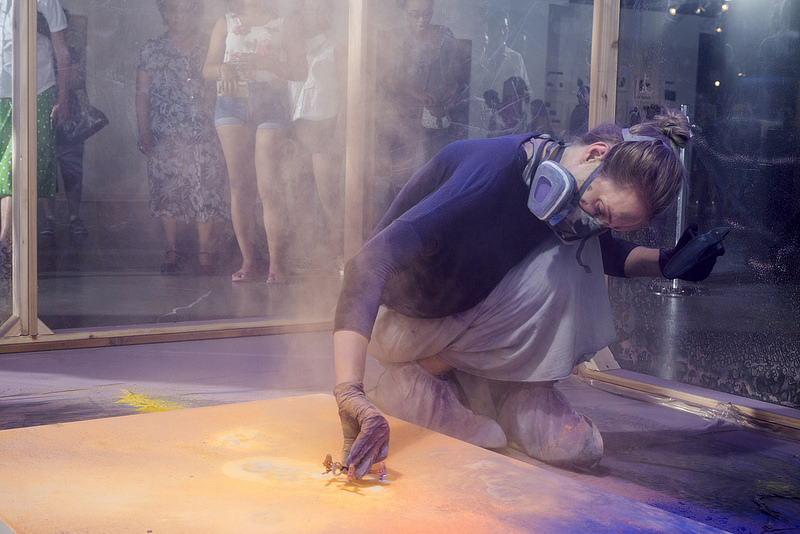
Portrait of Addie Wagenknecht, courtesy of Michael Clinard.
NR: Are there any tasks in your artistic practice you would want to automate?
AW: For a long time I wanted to automate the whole process. Some of the bigger artists, like Jeff Koons, never touch the work, everything is made by other people. This is a fascinating way to function as an artist. A lot of my friends who are established artists have become more of a creative director than this notion of an artist chipping away at a marble block. Coming up with the idea and finding the people who are good at it to execute it for you, that is what I enjoy. I do not know if it is going to be automated in the notion of it being a production line. I think it is all up to how it is contextualized. Anything fortunately or unfortunately can become art. It is just a question of how to contextualise it.
NR: This exhibition will also be on show at HeK in Basel. Next to this, your work is also on show in the Electronic Superhighway exhibition at Whitechapel Gallery in London. This indicates that there is a high interest in exhibiting internet related art. Can you describe how the interest in internet related art has changed in your opinion?
AW: For a long time internet based art was kind of ghettoized, which is not the right word. It was seen not as pure art or high art in the sense of being accepted by institutions and museums. It was an underground hacker scene thing, or haha “art” (in quotes). People would do it but it was never held or elevated to a level that traditional art was. Finally, in the last few years people are embracing screens, networks, and the internet, and we are switching from this being net art to this being art. There are some interesting artists that are doing interesting things with it and they do not call it net art, they call it painting, sculpture and other things. They are re-appropriating these traditional mediums and using the tools that are ubiquitous now. The switch is finally happening.
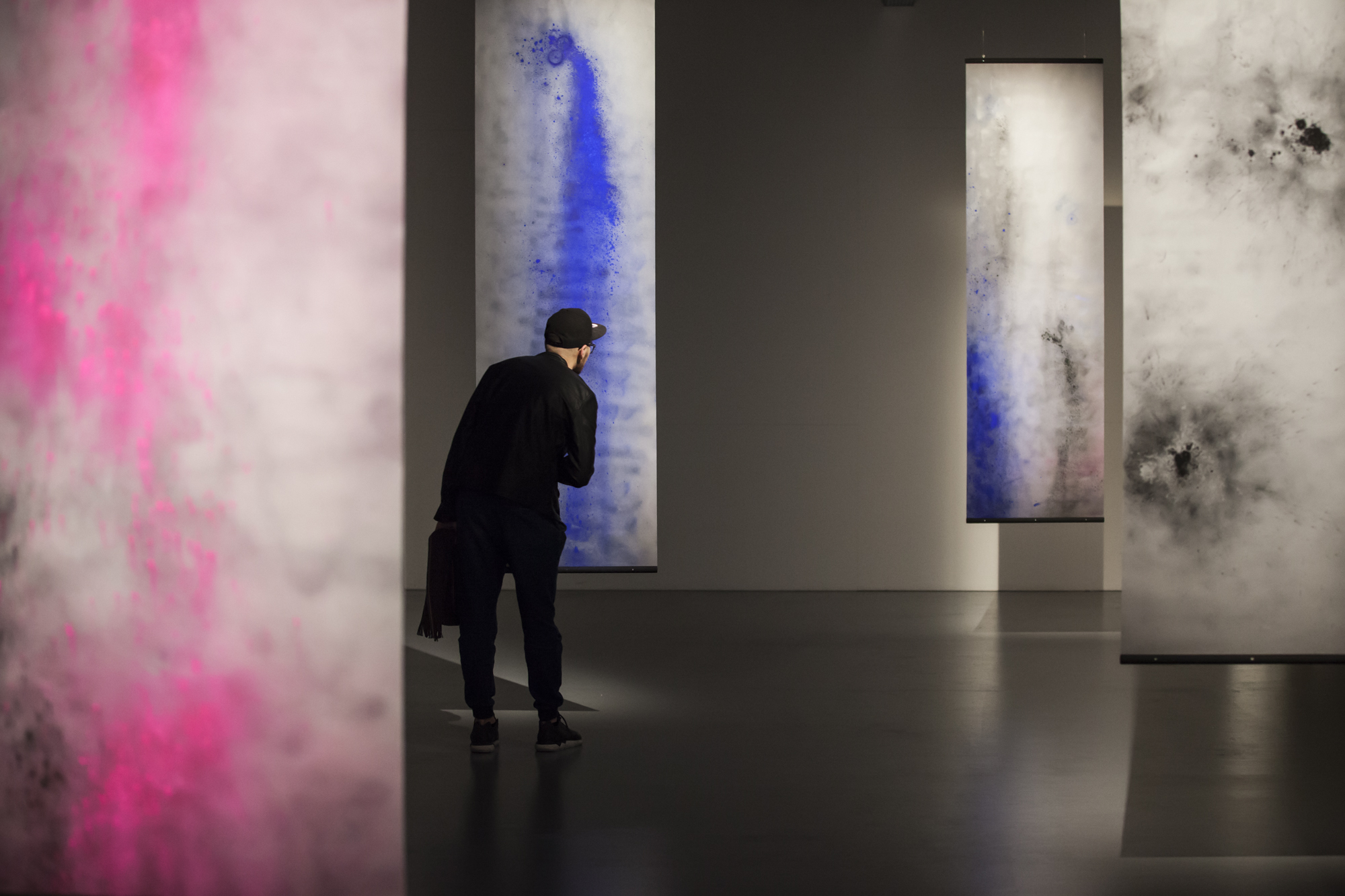 Black Hawk Powder (1-5) (2016) by Addie Wagenknecht. Photo © Hanneke Wetzer.
Black Hawk Powder (1-5) (2016) by Addie Wagenknecht. Photo © Hanneke Wetzer.
NR: What is on top of your agenda?
In the last shows I have done people always asked: “Who is the artist, I would like to meet him”. When I told them I was the artist I had a few people say to me: “But this is such male art”. I have been highly fixated on the question: is there gender to art? How do I make gender art? How do I make people come in and say this is a really feminine piece of art? I started to ask people about what they thought of as feminine art. It has flowers, it is pink and pretty. I started fixating on how to make pretty art, but when you look at it long enough you realize it is fucked up. Some of my experiences with the most beautiful women is that they are actually very broken. Same with men. How do I make a beautiful broken object, or how do I make a beautiful broken painting so that when you look at it you’re like this is very beautiful but when you study it you realize that it is molding or that there is something about it that is not okay. That is something I have started thinking a lot about. With the series Still Alive (2015) we wanted to make a work where you look at it and think, these are beautiful flowers but when you actually study the work you realise that person is taking Xanex and Prozac, they are on psychiatric medication. They are binging on donuts but drinking diet coke. It is like I am happy but I am on Prozac, I love my body but I am scared of getting fat. I think that everyone has some radical points of extremes. That is something I am starting to play with. How do I make something radically beautiful yet very broken, or off, or extreme, in this way that there is beauty but there is also a kind of grotesque aggression or something that makes you not initially uncomfortable. That is where I am going right now. I have started looking a lot into the notion of gender. What makes someone female versus male? It is not your sexuality at all. It is how you dress, how you do your hair, if you wear make up, things we have constructed as a society to define how to identify people.
NR: Does this have anything to do with the internet or technology?
AW: I think it has everything to do with the internet and digital technology. I recently discovered these selfie apps that let you change everything about you. They are amazing because I can get rid of all my zits or wrinkles, my teeth are super white, I can make my hair brown, black, light, and you can change your skin colour. Put that online and it is who people think you are. Your Instagram pictures are the highly curated you of you and how you want to be. It is not at all who you really are. This falsification of self is everything the internet exists for. These stories you hear of someone being in love with someone else and they think it is like this white blond girl and then they go to meet the person and it is actually like a 50 year old man. I think it is really interesting that the internet lets us become what we can’t necessarily be or feel comfortable being. You are allowed to be whoever you want to be online. It allows for that exploration.
Liminal Laws is on show at MU, Eindhoven until 19 June 2016. Meet the artist and join the discussion during the Deep Lab Day on 27 May!
This exhibition is a co-production, Liminal Laws is on show at H3K, Basel from 15 September 2016 until 06 November 2016.



